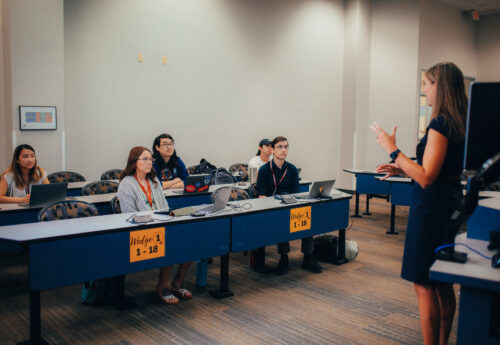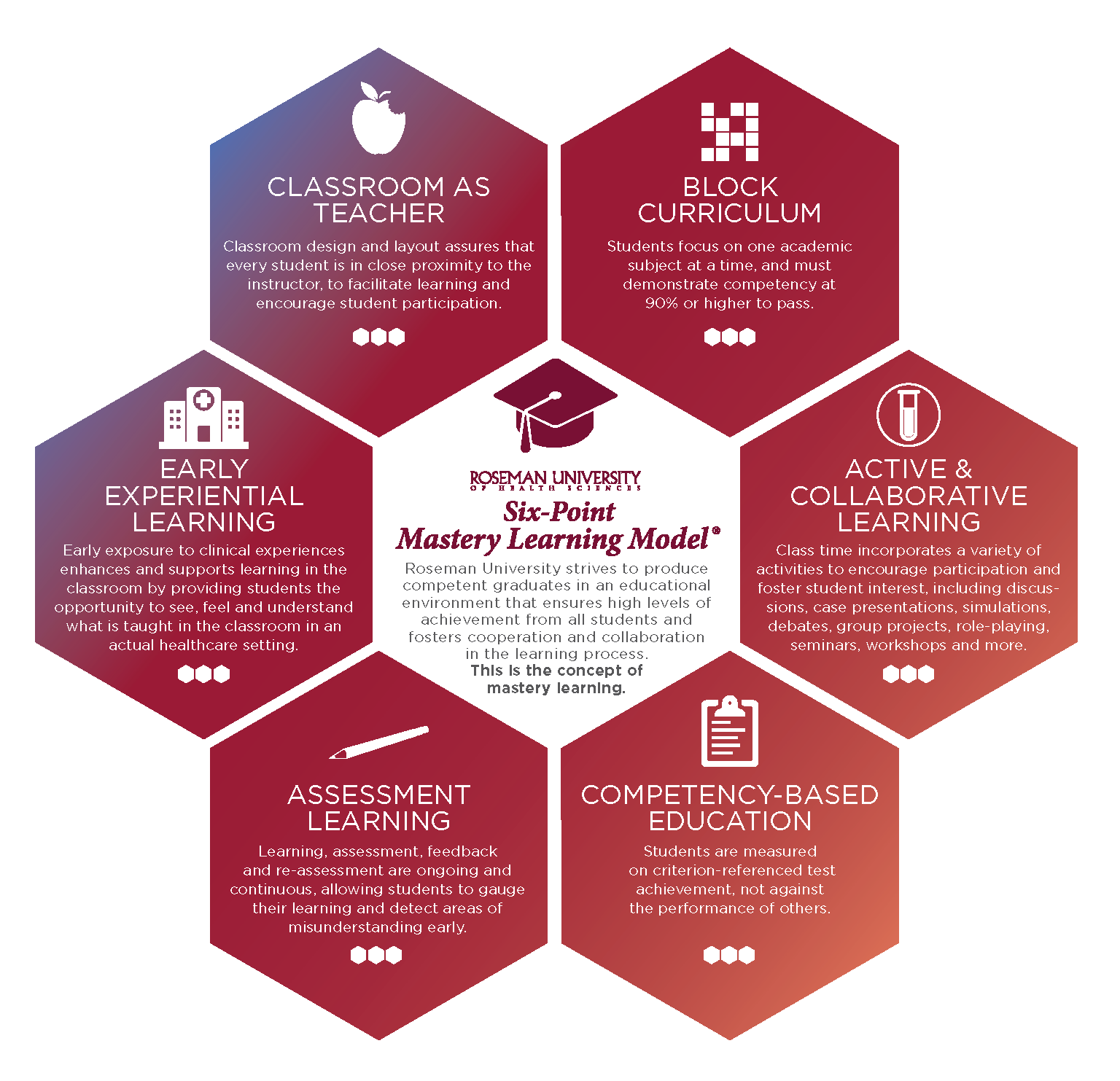Roseman University Six-Point Mastery Learning Model®
Roseman University uses unique teaching methods to produce graduates that are competent and to provide an educational environment that not only produces and ensures high levels of achievement from all students but also fosters cooperation and collaboration in the learning process. This is the concept of mastery learning.


The Roseman University Six-Point Mastery Learning Model® consists of Block Curriculum, Active and Collaborative Learning, Competency-based Education, Assessment Learning, Early Experiential Learning, and a Classroom Design that facilitates learning. All of these components reinforce one another and contribute to an unparalleled educational environment.
University Block Curriculum
With a block curriculum, students take only one didactic class at a time, focus intently on that content area, and master the content before proceeding to the next block or course. Students typically attend classes from 8 am to 3 pm daily, which is advantageous because faculty can deliver the classroom (didactic) component of the course content with more direct contact hours between faculty and students. It also encourages faculty to incorporate many different learning techniques, including discussions, activities, and breaks in the content delivery can occur naturally with the flow of instruction, so the important concepts can be reinforced.
Active & Collaborative Learning
With our unique teaching method, the Roseman University Six-Point Mastery Learning Model®, professors become more of an educational facilitator than that of a lecturer, incorporating a wide variety of activities that include the opportunity for students to listen, read, hear, think, discuss, reflect upon, and study each area intently during a given class period through discussions, case presentations, simulations, role-playing, debates, group projects, and various other activities that encourage participation, foster student interest, and increase motivation. These accommodate varied learning styles and reinforce the concepts, knowledge, and application of the materials presented by the professors. The system also incorporates a team environment that mirrors today’s healthcare settings. Instead of students competing with their peers to achieve the highest grades, the learning environment encourages and requires cooperation, creating more competent professionals who can work collaboratively with others.
Competency-based Education
Roseman University teaching method produces graduates that are competent, and to provide an educational environment that ensures high levels of achievement from all students. Most educational models determine student achievement based on norm-referenced exams and compare each student’s performance to that of his or her peers through a “curved” grading system with a passing grade set at around 70 percent.
By contrast, at Roseman University, student competency is determined based on criterion-referenced assessment tools. We believe that all professionals, especially those in health care, should be required to demonstrate competence at a high level.
Assessment Learning
Roseman University assessments are frequent, occurring every two to three weeks. Learning, assessment, feedback, and re-assessment are ongoing and continuous in the curriculum. Thus, students are better able to gauge their learning and detect areas of misunderstanding early so they can correct them prior to moving on to other subject areas.
Early Experiential Learning
Early exposure to clinical experiences is critical in building basic clinical skills. Roseman University enhances and supports learning in the classroom by providing students the opportunity to see, feel, and understand what was presented in the classroom in an actual healthcare setting at the beginning of their programs rather than one to two years after the completion of classroom learning.
Classroom As Teacher
Inclusive classroom design is the final piece of the Roseman University Six-Point Mastery Learning Model®. Classrooms are set up to form a hexagon, with the professor at the center, rather than a traditional lecture style with the professor at the front on the “stage” and the students in the “audience” observing the lecture or performance. Roseman University’s classroom layout assures that every student is in close proximity to the instructor, facilitating learning, and encouraging student participation.
Educational Philosophy
Statement of Educational Philosophy
Roseman University of Health Sciences is committed to the following educational ideals:
- An educational system in which all students can realistically attain high levels of achievement. We do not place emphasis on grades, rather on the achievement of curricular outcomes.
- An educational experience that goes beyond memorization of facts. We believe in the concept of deep learning and mastery of content that leads to understanding, the ability to apply knowledge and make wise decisions.
- A system of assessment designed to “detect and correct” problems thus ensuring achievement of high expectations by all students. We are committed to an assessment system that encourages and gauges progress toward the accomplishment of high academic standards by all students.
- An educational system that makes better use of time. We utilize the “block system” of curricular design, which provides students with the opportunity to study one content area intensely and master it without distractions from other subjects.
- A curricular design that stresses the importance of early exposure to the health profession for those in the health sciences. We believe in building basic skills early by exposing students where possible to early practice experiences.
- An educational experience that values and responds to the needs of students and encourages teamwork and communication. Our curriculum places a premium on active learning in a non-competitive, collaborative environment.
- A curriculum that utilizes and is supported by technology. We believe that technology holds the remarkable potential to stimulate thinking and learning, as well as being an effective tool for acquiring, evaluating, and utilizing new knowledge.